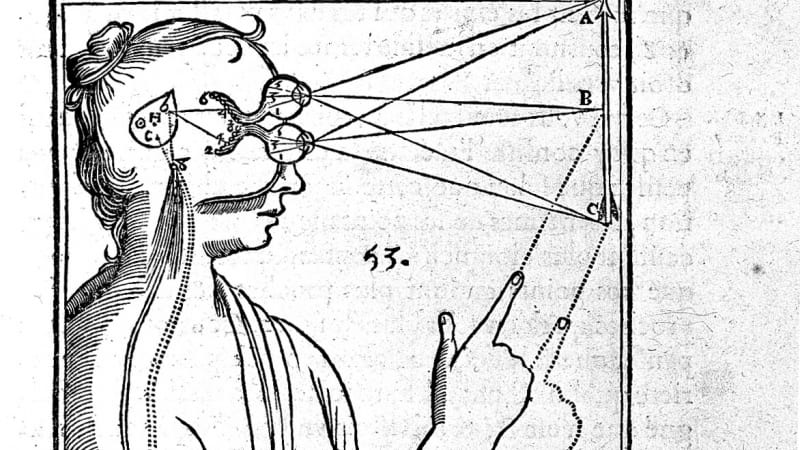NATURE’S MYSTERIES: THE SIXTH SENSE THAT COORDINATES OUR MOVEMENTS
By: Raeed Chowdhury

A diagram outlining the coordination of visual and muscle mechanisms, from Rene Descartes’ L’Homme (published in 1664). Image from the Wellcome Trust Library.
I grew up in a rural town in the middle of Missouri, where the most interesting thing to do at night was to go to the local park and watch the stars. One night as a teenager, on my way back home, I noticed a police car and truck stopped by the side of the road.
Both drivers were out on the street, and one of them seemed to be performing some sort of interpretive dance. The other looked to be critiquing the performance. Naturally, I slowed my car down for a closer look. As I watched, I realized that the critic (the cop) was instructing the other driver to stand straight up and, with eyes closed, touch each finger to his nose. The truck driver was not doing very well.
This strange dance, also known as a field sobriety test, is intended to test coordination. The idea is that if a person is not coordinated enough to touch his or her nose, then that person is probably not going to be coordinated enough to handle a steering wheel and pedals. While the field sobriety test is under intense criticism as an assessment of drunkenness, what is it actually meant to test?
That night, when the truck driver struggled, there was a disconnect between the physical position of his finger and where he sensed his finger to be. This sense – of bodily sensation and physical coordination — is not one of the five familiar senses everyone learns in grade school. Rather, it is a hidden, sixth sense called proprioception, which encompasses the sensations of body positioning, movement, and forces.
Proprioception arises from small sensors in the body that specialize in sending information about the body. Some sensors, called muscle spindles, are embedded alongside normal muscle fibers. They sense the length (and changes in length) of the muscle as it stretches and contracts with movement. Other sensors, called Golgi tendon organs, are embedded in the tendons, where the muscles connect to bone. These tendon organs sense how much force a muscle is outputting. While these muscle-related sensors are the main contributors to the sensation of proprioception, there are a plethora of other sensors in the skin and joints that sense movement, too. All of these sensors send electrical signals along the fastest and most direct nerves in the body, some fast enough to cross a football field in less than a second. When they arrive in the brain, these signals are assembled together and interpreted to form the actual sense of proprioception.
You and I both use our proprioception every day without even realizing it. Even a task as simple as reaching for a cup of coffee involves a staggering amount of neural computation: your eyes see the cup; your proprioception tells you where your hand is; you navigate your hand to the cup; on the way there, your proprioception helps you coordinate the sequence of muscle contractions as your arm and fingers travel — first to the cup and then around its handle. Finally, when you pick up the cup, you automatically adjust the force your arm muscles use, compensating for the precise weight of the cup (whether it is empty or full, for example).
Our sense of proprioception transforms the on-going signals to and from our muscles, allowing us to move our arms and hands without a second thought. While researchers have known that this physical information processing happens for awhile, we are only now starting to understand how this sensor signal transformation and fusion occurs in the brain, as well as how it might relate to controlling movements.
The simple task of picking up a cup or touching your nose become incredibly difficult with an impaired sense of proprioception. Individuals who are inebriated often struggle with coordination for this reason. Fortunately for the tipsy, the effects are usually temporary. Normal proprioception returns to them after alcohol leaves their system. But the study of proprioception is not just about explaining what happens when people get drunk. There is, in fact, a population of people who either partially or fully lose their sense of proprioception permanently.
Whether through spinal cord injury or a degenerative disease, many people’s bodies cannot transmit signals from their muscle sensors to their brain, leaving them uncoordinated at best. Through the study of proprioception, researchers like me are trying to understand what exactly they’re missing, and eventually, we may even be able to help bring back their hidden sixth sense.
This article began as a class assignment for Skills & Careers in Science Writing, a graduate-level science writing course focusing on building compelling narratives and employing storytelling techniques to illuminate contemporary research. The course is a partnership between Science in Society, The Graduate School, and the Medill School of Journalism, Media, and Integrated Marketing Communications at Northwestern University.
